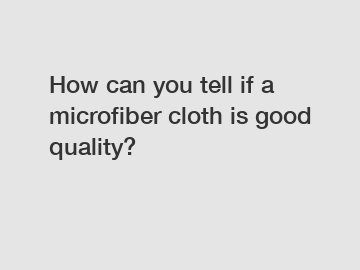How can you tell if a microfiber cloth is good quality?
Link to Jiuyuan
In the world of cleaning, microfiber cloths have become a staple due to their exceptional ability to trap dirt and absorb moisture. However, not all microfiber cloths are created equal. Some are downright ineffective, while others offer outstanding performance. So, how can you distinguish between good quality and subpar microfiber cloths? In this blog, we will guide you through the key factors to consider when assessing the quality of a microfiber cloth. Armed with this knowledge, you can make an informed decision and ensure efficient cleaning results.
1. Softness and Texture:

One of the primary indicators of a high-quality microfiber cloth is its softness. Pass your hand over the cloth's surface; a superior microfiber cloth will feel silky smooth. The material should exhibit a dense yet plush texture, ensuring it won't scratch delicate surfaces, such as glass or polished furniture. Inferior quality cloths often feel rough and may cause damage over time.
2. Fiber Density and Pile Length:
Fiber density is a crucial element that affects cleaning efficiency. Look closely at the cloth's surface as it catches the light. High-quality microfiber cloths have densely packed fibers, creating a visually consistent and uniform appearance. A low-density cloth may appear sparse, resulting in reduced absorbency and cleaning performance.
Additionally, consider the pile length of the microfiber cloth. Longer fibers tend to offer better dust and dirt trapping capabilities. The increased surface area enables the cloth to capture particles effectively, leaving surfaces spotless. So, opt for a microfiber cloth with a substantial pile length for enhanced cleaning power.
3. Construction and Edge Quality:
A well-constructed microfiber cloth is a testament to its quality. Inspect the cloth to ensure it has sturdy stitching and securely bound edges. Lesser quality cloths may have loose threads or frayed edges, indicating poor craftsmanship. Such flaws can affect durability and may cause linting or shedding during use, hindering the cleaning process.
4. Absorbency and Dirt Trapping:
One of the greatest advantages of microfiber cloths lies in their impressive absorbency. Good quality microfibers are designed to hold a substantial amount of liquid, making them ideal for wiping down surfaces without leaving streaks or watermarks. To test a microfiber cloth's absorbency, slightly dampen a small area on the cloth and observe how well it retains moisture.
Moreover, effective dirt trapping is another hallmark of a reliable microfiber cloth. The cloth's fibers should efficiently capture and retain dust, debris, and particles within their structure, rather than merely redistributing them. A high-quality cloth will prevent the transfer of dirt back onto surfaces, leaving them clean and clear.
5. Laundering and Longevity:
A durable microfiber cloth should withstand repeated washings without losing its efficiency or deteriorating. Check if the cloth's label specifies it as machine washable. Additionally, microfiber cloths with colorfast properties ensure that dyes won't bleed during laundering, preventing any potential staining of surfaces. A good quality microfiber cloth should retain its softness, texture, and cleaning performance even after multiple washes.
Conclusion:
Choosing the right microfiber cloth can undoubtedly elevate your cleaning experience and achieve superior results. By considering the factors mentioned above – softness, fiber density, construction quality, absorbency, dirt trapping, laundering properties, and longevity – you can easily identify a high-quality microfiber cloth. Remember, investing in a trustworthy, reliable product will not only save you money in the long run but also make your cleaning tasks more enjoyable and effective. So, next time you reach for a microfiber cloth, ensure you're equipping yourself with nothing less than the best!
You can find more information on our web, so please take a look.
For more information, please visit microfiber mop wholesale.



